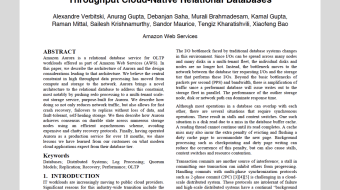Customer-obsessed science


Research areas
-
September 26, 2025To transform scientific domains, foundation models will require physical-constraint satisfaction, uncertainty quantification, and specialized forecasting techniques that overcome data scarcity while maintaining scientific rigor.
-
Featured news
-
2024Schema matching constitutes a pivotal phase in the data ingestion process for contemporary database systems. Its objective is to discern pairwise similarities between two sets of attributes, each associated with a distinct data table. This challenge emerges at the initial stages of data analytics, such as when incorporating a third-party table into existing databases to inform business insights. Given its
-
2024Dialog systems, such as voice assistants, are expected to engage with users in complex, evolving conversations. Unfortunately, traditional automatic speech recognition (ASR) systems deployed in such applications are usually trained to recognize each turn independently and lack the ability to adapt to the conversational context or incorporate user feedback. In this work, we introduce a general framework
-
2024Recent advances in retrieval-augmented generation (RAG) have initiated a new era in repository-level code completion. However, the invariable use of retrieval in existing methods exposes issues in both efficiency and robustness, with a large proportion of the retrieved contexts proving unhelpful or harmful to code language models (code LMs). In this paper, we propose a selective RAG framework to avoid retrieval
-
Finite-time convergence and sample complexity of actor-critic multi-objective reinforcement learning2024Reinforcement learning with multiple, potentially conflicting objectives is pervasive in real-world applications, while this problem remains theoretically under-explored. This paper tackles the multi-objective reinforcement learning (MORL) problem and introduces an innovative actor-critic algorithm named MOAC which finds a policy by iteratively making trade-offs among conflicting reward signals. Notably
-
2024Existing Large Language Models (LLMs) usually remain static after deployment, which might make it hard to inject new knowledge into the model. We aim to build models containing a considerable portion of self-updatable parameters, enabling the model to integrate new knowledge effectively and efficiently. To this end, we introduce MemoryLLM, a model that comprises a transformer and a fixed-size memory pool
Collaborations
View allWhether you're a faculty member or student, there are number of ways you can engage with Amazon.
View all














































